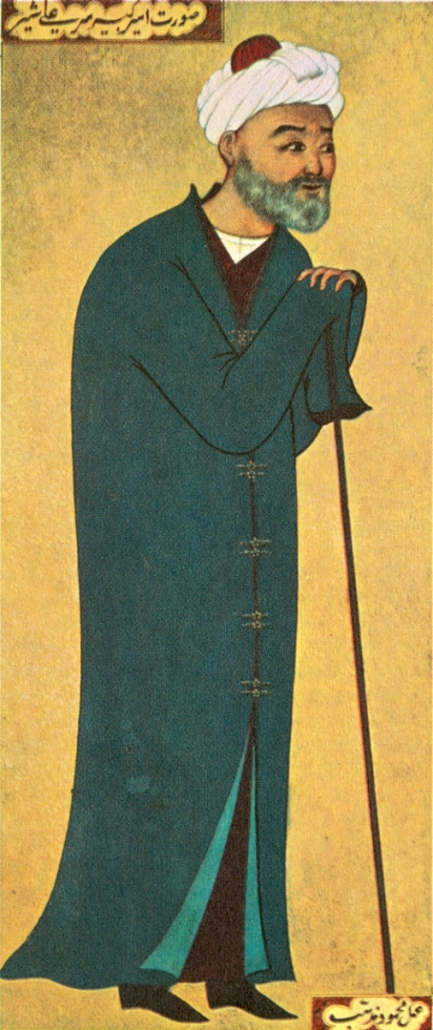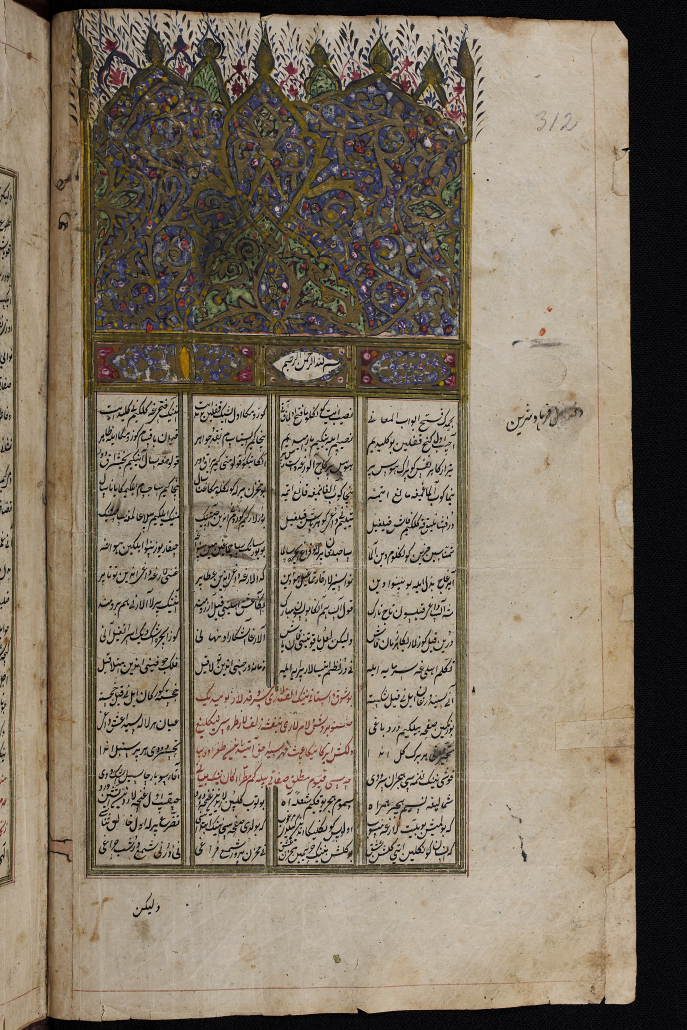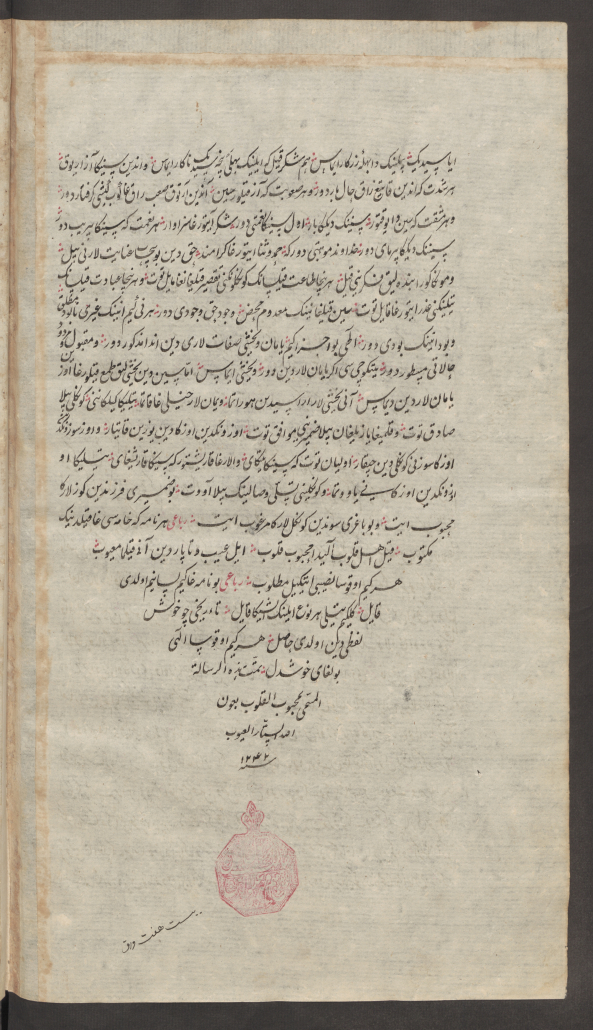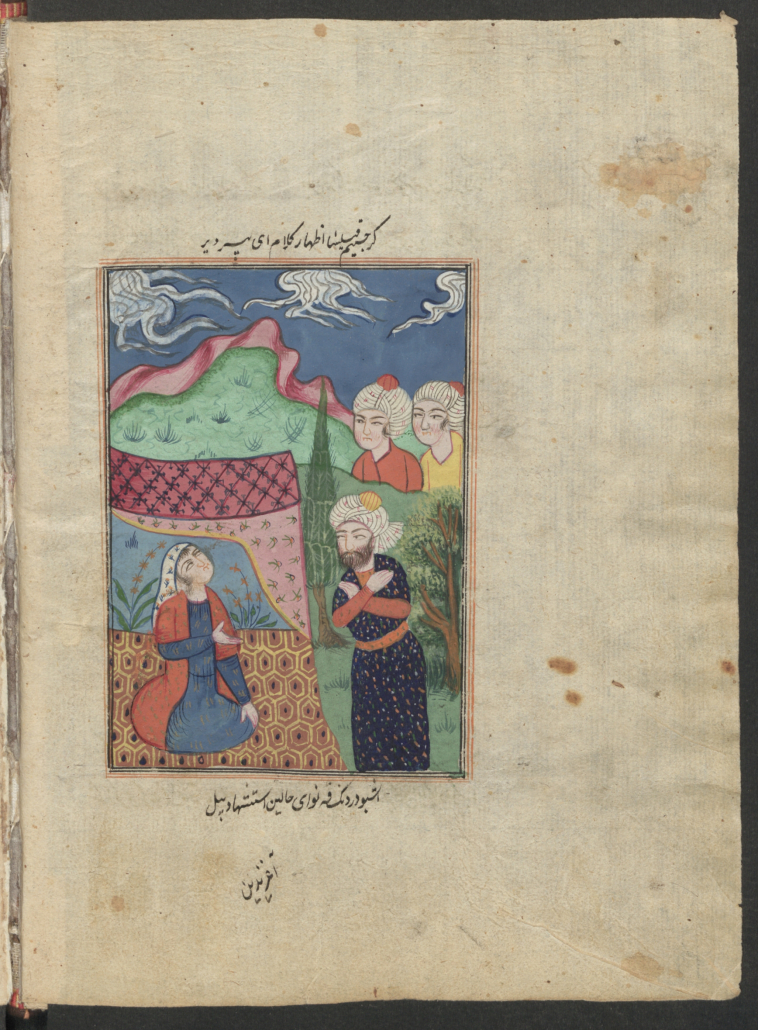Nava’i Manuscripts in the Berlin State Library
The Central Asian poet, writer, philologist and painter, Mir Ališer Nava’i (میر علی شیر نوایی, 1441 – 1501), also known as Nizam ad-Din Mir Ališer Nava’i (نظام الدین علی شیر نوایی), was born into an educated and wealthy Uyghur Bakhshī family in Herat. He is considered the most important poet of Chagatai literature. Under the pen name Nava’i (نوایی), he wrote 30 works in Chagatai. Most poets writing under the Timurid dynasty rarely used Chagatai. While all his contemporaries wrote their works exclusively in Persian, Nava’i only composed a few works in this language which he published under the pen name Fāni (فانى). Due to his profound knowledge of the Persian language and literature, he was able to refine Chagatai and develop it into a literary language.
Sulṭān Ḥusayn Mīrzā Bāyqarā (سلطان حسین مرزا بایقرا, 1438-1506), the last Timurid ruler and the best friend of Nava’i, was also influenced by his literary style. The Dīwān Sulṭān Ḥusayn Mīrzā Bāyqarā (سلطان حسین مرزا بایقرا دیوان, Hs. or. 10434) can be seen as an example of this style. Nava’i was one of those scholars who dedicated their whole life to learning. He never married, and spent most of his life as a public administrator and advisor to Sulṭān Ḥusayn Mīrzā Bāyqarā.
Chagatai, a widespread medieval Turkic language, was the language in which Nava’i preferred to express himself. The writings of Nava’i were instrumental in turning Chagatai into a highly prestigious language in Central Asia. His famous works include the Dīwān (دیوان), Ḫamsa (خمسه), Muḥākamāt al-luġatain (محاكمةاللغتين), Maǧālis an-nafā’is (مجالس النفائس), Lisān aṭ-ṭair (لسان الطیر), Munša’āt (منشعات), Mīzān al-Auzān (ميزان الاوزان), and others.

A 16th century Herat School miniature of Mir Ališer Nava’i
The Collection of Nava’i Manuscripts
There are a number of libraries and institutions in the world where manuscripts of Islamic Central Asian origin are preserved. The precious Nava’i manuscripts are widespread, and today, most of them are located in the National Library of Russia (St. Petersburg), the Al-Biruni Institute of Oriental Studies (Tashkent), the British Library (London), Sülaymaniye Kütüphanesi (Istanbul), and the Topkapi Palace Library (Istanbul). Unfortunately, most of his manuscripts are not available online.
The Berlin State Library has a total of 29 Nava’i manuscripts. They came not only from the Diez, Hartmann, and Huth Collections, but belonged to other Orientalists and booksellers as well. This small collection contains six Dīwāns (دیوان), two Kulliyāts ( کلیات), two or three Ḫamsas (خمسه), and individual compositions such as Maǧālis an-nafā’is (مجالس النفائس), Lisān aṭ-ṭair (لسان الطیر), Maḥbūb al-qulūb (محبوب القلوب), etc. The following is a comprehensive overview of the Nava’i manuscripts in the State Library’s possession:
Among the Diez Albums, there are four manuscripts with works by Nava’i: Iskandar-nāme (اسکندرنامه, Diez A. oct. 67), Maǧālis an-nafā’is (مجالس النفائس, Diez A. oct. 100), Ḫamsat al-mutaḥayyirīn (خمسة المتحيّرين, Diez A. oct. 139) and the Dīwān (دیوان , Diez A. quart. 99). All these manuscripts date from the 16th century and are described in the Catalogue of Turkish Manuscripts. The Ḫamsat al-mutaḥayyirīn (خمسة المتحيّرين) was copied in 1525 and is held to be the oldest manuscript in the whole Nava’i manuscript collection.
From the Hartmann Collection, there are Ḫamsa (خمسه, Ms. or. fol. 3291) (Ill. 1), Maḥbūb al-qulūb (محبوب القلوب, Ms. or. oct. 1664, 1687), Lisān aṭ-ṭair (لسان الطیر, Ms. or. oct. 1715), selected ghazals by Nava’i (غزليات, Ms. or. oct. 1695, 1736; Ms. or. quart 1286) and an anthology of his selected works (Ms. or. oct. 1683).
From the Huth Collection, there are Kulliyāt (کلیات, Ms. or. fol. 3302), Maḥbūb al-qulūb (محبوب القلوب, Ms. or. oct. 1740) and selected ghazals (غزليات, Ms. or. oct. 1736) by Nava’i.
From other smaller collections there are Kulliyāt (کلیات, Ms. or. fol. 4054) (Ill. 2), Bahram u Dilaram (بهرام ديلارام, Minutoli 294), Iskandar-nāme (اسکندرنامه, Sprenger 1652), Maǧālis an-nafā’is (مجالس النفائس, Ms. or. oct. 52), a Maṯnawī collection (مثنوی, Sprenger 1651), the Dīwān (دیوان, Ms. or. oct. 481, 961, 1741, 1742, 1744, 1745; Ms. or. quart. 1570), Ḫamsa (خمسه, Ms. or. quart. 1737) and a collection of poetry by Nava’i (Ms. or. oct. 1750). The Dīwān (دیوان, Ms. or. quart. 1570) (Ill. 3) is the only work by Nava’i including five miniatures, making it a rarity and an object of special interest among Central Asian manuscripts. It has been surmised that the miniatures are considerably younger than the copy. Besides the manuscripts listed above, there are also several dictionaries that were produced specially to go with manuscripts of Navai’s works (see Diez A oct. 143, Diez A oct. 48).
Ill. 1: Ḫamsa by Mir Ališer Nava’i
This recent copy of “the Quintuple” was acquired by Martin Hartmann in 1902 in Tashkent.
Tashkent, 1244–1249 (1828–1833), SBB-PK, Oriental Department, Ms. or. fol. 3291, p. 312.
Ill. 2: Kulliyāt by Mir Ališer Nava’i
This manuscript was acquired in 1926 from the estate of the Evangelical missionary Johannes Avetaranian and is considered the most complete version of Kulliyāt by Nava’i.
Kashgar, 1261/1845, SBB-PK, Oriental Department, Ms. or. fol. 4054, fol. 623v.
Ill. 3: Dīwān by Mir Ališer Nava’i
Miniatures were added to the older manuscript in the 19th–20th centuries.
Central Asia, undated, SBB-PK, Oriental Department, Ms. or. quart. 1570, fol. 88v.
Cataloguing and Digitization
There are many catalogues of Islamic or Turkish manuscripts held in museums, libraries or institutes. Usually, Chagatai manuscripts are subsumed under Turkish manuscripts in the catalogues.
As of today, no comprehensive catalogue has been published covering the entire Chagatai holdings. Pertsch’s catalogue (1889) records 22 Chagatai manuscripts, six of which are works of Nava’i. The works of Nava’i from the Hartmann Collection are mostly copies from the 18th to 19th centuries; all of them have been described by the collector briefly and succinctly in a 1904 compendium “Die Osttürkischen Handschriften der Sammlung Hartmann” [The East Turkic Manuscripts of the Hartmann Collection]. In Manfred Götz’s catalogue (1979), there are 31 Chagatai manuscripts listed, six of which are works of Nava’i. These catalogues provide us with important information about the manuscripts. However, there are still a number of manuscripts which are not included in these catalogues and are still waiting to be catalogued. Nowadays, many institutes and libraries focus on digitization. This also holds true for the Berlin State Library, where the project called “Qalamos” has been started in cooperation with the Data Center at the University of Leipzig. At present, six works of Nava’i manuscripts have been digitized from the entire Chagatai collection.
The Chagatai manuscripts from the library have been somewhat less researched in comparison with other oriental manuscripts. Only a few of the manuscripts are mentioned in some scholarly articles. Nevertheless, interest in researching Chagatai manuscripts has grown in past years. This preliminary study hopes to help establish a basis for further research. Chagatai Manuscripts require even more intensive research from multiple perspectives, including historical, social and economic, in the future.
Further Sources
Catalogues
::: GÖTZ, MANFRED 1979: Türkische Handschriften. Verzeichnis der orientalischen Handschriften in Deutschland [Turkish Manuscripts: Index of Oriental Manuscripts in Germany], Vol. XIII, 4, Wiesbaden.
::: HARTMANN, MARTIN 1904: Die Osttürkischen Handschriften der Sammlung Hartmann [The East Turkish Manuscripts of the Hartmann Collection], In Türkische Handschriften verzeichnet in den Mitteilungen des Seminars für Orientalische Sprachen [Turkish Manuscripts Listed in Reports of the Seminar of Oriental Languages], VII /2, pp. 1-21.
::: PERTSCH, WILHELM 1889: Die Handschriften-Verzeichnisse der königlichen Bibliothek zu Berlin [Inventories of Manuscripts in the Berlin Royal Library], vol. 6., Berlin.
Secondary Literature
::: MIRSULTAN, AYSIMA 2014: Chagatai manuscripts at the Berlin State Library. In Türk dilleri Araṣtırmaları 24/2, pp. 191-207.
::: MIRSULTAN, AYSIMA 2019: Manuscripts of Alishir Navo’i works in the Berlin State Library. In: The cultural legacy of Uzbekistan: Collections of the Federal Republic of Germany. Tashkent: East Star Media, Vol. 11, pp. 164-181. (In English, Russian and Uzbek)
::: ÖLMEZ, ZUHAL 2007: Çağatay Edebiyatı ve Çağatay Edebiyatı üzerine Araştırmalar. In: Türkiye Araştırmaları Literatür Dergisi 5, 9, pp. 173-219.
::: SUBTELNY, MARIA EVA 2013: “Mīr ʿAlī Shīr Nawāʾī”. In: Encyclopaedia of Islam, Second Edition. Brill Online (Access via Staatsbibliothek zu Berlin).
::: SUGAWARA, JUN 2008: ドイツ連邦共和国所蔵の新疆史料について . マルティン・ハルトマン収集写本と関連資料. In: SHINMEN YASUSHI (新免康) ed. 中央アジアにおけるウイグル人地域社会の変容と民族アイデンティティに関する調査研究. pp. 53-70.


